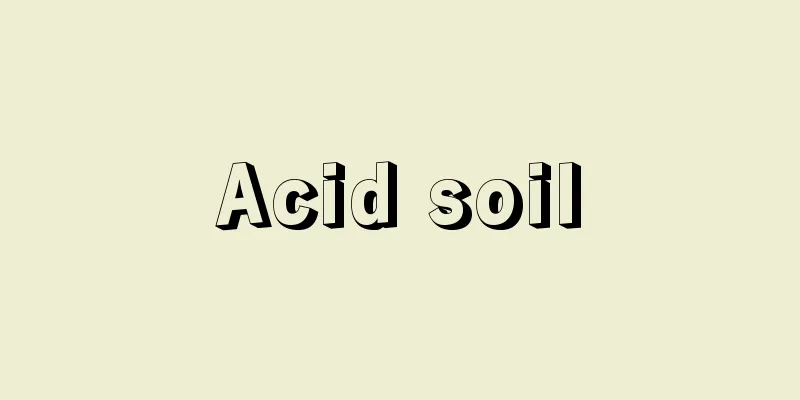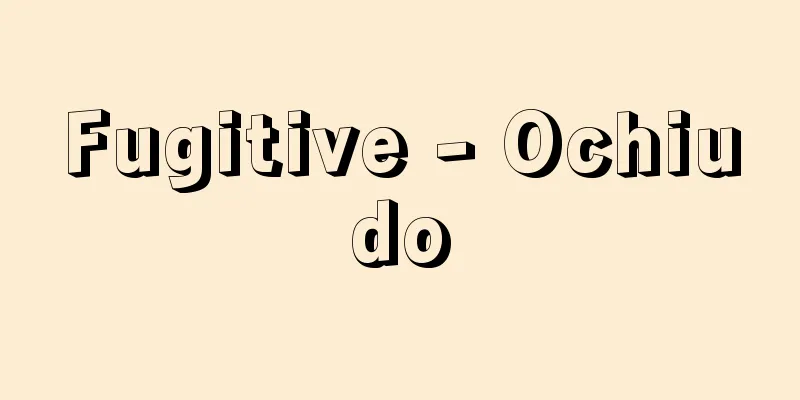Acid soil

|
Soil with a hydrogen ion concentration (pH) of 6.5 or less, measured by adding distilled water (usually 2.5 times the volume of the soil) to a small amount of soil. pH values up to 6.0 are considered slightly acidic, up to 5.5 weakly acidic, up to 5.0 moderately acidic, up to 4.5 strongly acidic, and below that are considered extremely acidic. These are sometimes used as a guideline to distinguish the degree of acidity. Soil acidity is basically due to weathering in a humid climate and the production of humic acid accompanying the decomposition of plant remains. In deserts or desert-like regions where weathering and vegetation are scarce, most soils are neutral (pH around 7.0) or slightly alkaline, but soils in humid regions are acidic to various degrees. Just below the surface of the podzol is the most strongly acidic A2 layer (E layer), and it is not uncommon for the pH to reach 3 to 4. Brown forest soils and red-yellow soils from temperate to tropical regions often have acidic (moderate to strong) A and B layers. Japan has a lot of rainfall throughout the year, so acidic soils are widely distributed. When the soil becomes acidic, harmful aluminum ions are adsorbed to the surface of the soil particles, impairing plant growth. When neutral potassium salts are added to soil, the pH of weathered soil tends to become even lower. This is because the colloidal clay particles in the soil have adsorbed hydrogen ions (or aluminum ions). By measuring the acid extracted by potassium chloride in this way (measuring replacement acidity), the latent acidity of the soil can be determined, and therefore the approximate degree of weathering of the soil. Acidic soils can be found locally in areas around volcanoes affected by the elution of sulfides, and in rice paddy soils on reclaimed land. Acidic soil is generally unfavorable for the growth of agricultural crops, but some types of crops are sensitive to acidity and others are not so affected by it. Plants that like acidity include tea, tobacco, taro, rice, kudzu, Japanese silver grass, and azalea, while plants that dislike acidity include lettuce, barley, spinach, eggplant, leeks, and peas. Plants that are not affected much by the acidity of the soil include radishes, sweet potatoes, tomatoes, potatoes, turnips, and wheat. Factors that inhibit the growth of crops in acidic soil include the harmful effects of hydrogen ions themselves, as well as excess damage caused by aluminum ions and manganese ions that dissolve in acidic soils, the inability to supply phosphorus, and a deficiency of bases and trace elements. Of these, the most serious damage is excess damage caused by aluminum ions. To avoid this damage, it is necessary to correct the hydrogen ion concentration index of the soil to pH 5.5 or higher. [Shigeo Asami, Yuo Koyama, Makiko Watanabe] "Acid soil and crop growth" by Takeshi Hashimoto (1981, Yokendou) "Acid soil and its agricultural use - especially in the tropics, the present and future" by Akira Tanaka (1984, Hakuyusha) "Low pH soil and plants" edited by the Japanese Society of Soil Science and Plant Nutrition (1994, Hakuyusha) [Reference] | | | | | |Source: Shogakukan Encyclopedia Nipponica About Encyclopedia Nipponica Information | Legend |
|
少量の土に蒸留水(通常、土の容積の2.5倍の水)を加えて測定した水素イオン濃度(pH)値が6.5以下のときの土壌。pH値6.0までは微酸性、5.5までを弱酸性、5.0までを中酸性、4.5までを強酸性とし、それ以下を極強酸性として、酸性の程度を区別する目安とすることもある。 土壌の酸性は、基本的には多湿気候下の風化作用と、植物遺骸(いがい)の分解に伴う腐植酸の生成とに由来する。風化や植生の作用に乏しい砂漠または砂漠に近い地方には、ほとんど中性(pH7.0前後)または微アルカリ性の土壌が多いが、湿潤地方の土壌は種々の程度に酸性化している。ポドゾルの表層直下にはもっとも強酸性のA2層(E層位)があり、pH3~4に達するものもまれではない。温帯から熱帯にかけての褐色(かっしょく)森林土や赤黄色土も、A、B層に酸性(中~強)を呈するものが多い。日本はどこでも年間を通じて雨量が多いので酸性土壌が広く分布している。土壌の反応が酸性に傾くと、土壌粒子の表面に有害なアルミニウムイオンが吸着して植物の生育を害する。 土に中性のカリウム塩を加えると、風化の進んだ土壌のpHはさらに低くなる傾向がある。これは土壌中のコロイド状粘土粒子が水素イオン(またはアルミニウムイオン)を吸着していたからで、このように塩化カリウムによって抽出された酸を測定する方法(置換酸性の測定)によると、潜在していた土壌の酸性がわかり、それによって土壌のおおよその風化度を知ることができる。酸性土壌は、硫化物の溶出の影響を受けた火山周辺地方や、干拓地の水田土壌などに局地的分布を示すことがある。 酸性土壌は一般に農作物の生育に不利であるが、農作物の種類により酸性に弱いものとあまり酸性の害を受けないものとがある。酸性を好むものとしてはチャ、タバコ、サトイモ、イネ、クズ、ススキ、ツツジなどがあり、逆に酸性を嫌うものにチシャ、オオムギ、ホウレンソウ、ナス、ネギ、エンドウがある。また土壌の酸性度にあまり影響されない作物はダイコン、サツマイモ、トマト、ジャガイモ、カブ、コムギなどである。酸性土壌における作物の生育阻害要因としては、水素イオンそのものの害作用に加え、酸性で溶解してくるアルミニウムイオン、マンガンイオンの過剰障害、リン酸の不可給化、塩基、微量要素の不足などが知られている。これらのなかで、もっとも深刻なのはアルミニウムイオンの過剰障害である。この害を回避するにはpH5.5以上に土壌の水素イオン濃度指数を矯正する必要がある。 [浅海重夫・小山雄生・渡邊眞紀子] 『橋本武著『酸性土壌と作物生育』(1981・養賢堂)』▽『田中明著『酸性土壌とその農業利用――特に熱帯における現状と将来』(1984・博友社)』▽『日本土壌肥料学会編『低pH土壌と植物』(1994・博友社)』 [参照項目] | | | | | |出典 小学館 日本大百科全書(ニッポニカ)日本大百科全書(ニッポニカ)について 情報 | 凡例 |
<<: Acid mordant dye - Sanseibaisensenryo
>>: Sanseido Co., Ltd. - Sanseido
Recommend
Dutch East India Company - Dutch East India Company
A joint stock company established in 1602 by mergi...
Yao [town] - Yao
A former town in Fushiki District, southern Toyama...
Frog-eye clay - Gaeromenendo
A type of clay containing a large amount of quartz...
Konoe Motomichi
Year of death: Tenpuku 1.5.29 (1233.7.8) Year of b...
Oxo
[ I ] A prefix used to name carbonyl compounds as...
Gubec, M.
…In response, the native Croatian feudal nobles, ...
United Press International
…Abbreviation for United Press International, one...
Labour force participation rate
Also called the labor force ratio or labor populat...
Dutschke, R.
…Young people who led the student movement (SDS) ...
Wirgman, Charles
Year of death: February 8, 1891 Born: August 31, 1...
Fraxinus
...A deciduous tree of the Oleaceae family. In th...
Pathotoxin
…Among the metabolic products secreted by plant p...
Eckhart - Meister Johannes Eckhart
A medieval German mystic thinker. Born in central...
Diversification of management
The expansion of a company's business activiti...
Yō
These dolls were made as grave goods. They are a ...









